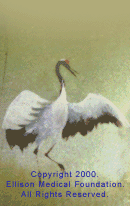 |



Senior Scholar Award in Aging

|
Spyridon
Artavanis-Tsakonas,
Ph.D.
Massachusetts General Hospital Cancer Center
|
A Novel Class of Aging Genes in Drosophila melanogaster
The aging of an organism is determined by its genetic background and is influenced by environmental inputs. Genetically, aging is considered to be a polygenic process; however, studies in model systems revealed mutations in single loci that extend life span. The best established epigenetic intervention that prolongs life is caloric restriction and consistent with this notion, some of the mutations that have been shown to affect life span are thought to mimic conditions akin to reduced caloric uptake. A physiological state that simulates caloric restriction seems to be achieved by mutations in genes that affect energy metabolism either directly, by reducing the transport of Krebs cycle intermediates (Indy gene in Drosophila and C. elegans,) or indirectly, through a reduction in insulin signaling that changes the mode of energy metabolism (chico, InR in Drosophila and their homologues in C.elegans and mice).
Over the years our laboratory has been focused on analyzing the molecular mechanisms of cell fate control in development. Most of our work centers on the Notch signaling pathway, which defines one of the few cell interaction mechanisms that form the signaling backbone of metazoan development. Notch action is highly pleiotropic affecting a variety of tissues and developmental processes throughout development by virtue of a rather ill understood crosstalk between Notch signals and other cellular elements. In our ongoing effort to identify the genetic circuitry that has an impact on Notch signaling, we have identified a modifier of an activated Notch phenotype a Drosophila gene that we called enigma (egm) . Our studies thus far indicate that enigma is linked to beta oxidation and significantly, affects dramatically the lifespan of the fly, increasing mean and maximal life span by 40% and 60%.
The goal of the present proposal is to characterize enigma and determine if it represents the paradigm for a novel class of aging mutation in Drosophila, linked directly or indirectly to beta oxidation. We are employing classical as well as genomic approaches to address these questions. It is our hope that an elucidation of enigma biology will not only provide functional insights to the relationship between energy metabolism and aging but it will also provide a link and perhaps a tool to examine relationships between basic, developmentally important signaling mechanisms and organismal physiology and homeostasis.
Contact
Dr. Artavanis-Tsakonas.
|
 |

